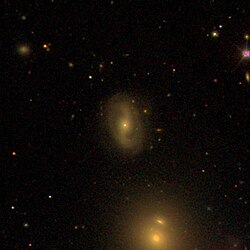| NGC 998 | |
|---|---|
 SDSS image of NGC 998 | |
| Observation data (J2000 epoch) | |
| Constellation | Cetus |
| Right ascension | 02h 37m 16.50891s [1] |
| Declination | +07° 20′ 08.7169″ [1] |
| Redshift | 0.02184 [2] |
| Heliocentric radial velocity | 6476 km/s [2] |
| Distance | 303.7 ± 21.4 Mly (93.11 ± 6.56 Mpc) [3] |
| Apparent magnitude (B) | 14.6 [2] |
| Absolute magnitude (V) | -23.46 +/- 0.51 [2] |
| Characteristics | |
| Type | S? [2] |
| Other designations | |
| MCG +01-07-015, PGC 9934 [2] | |
NGC 998 is a spiral galaxy in the constellation Cetus. It is estimated to be 294 million light years from the Milky Way and has a diameter of approximately 90,000 ly. Together with NGC 997, it forms a gravitationally bound pair of galaxies. NGC 998 was discovered by astronomer Albert Marth on 10 November 1863 using a 48-inch telescope. [4] [5] [6]